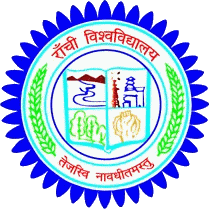General Information
Ranchi University, established in 1960, is one of the oldest and most significant public State Universities in Jharkhand. Carved out of the original Patna University to serve the new state (then part of Bihar), it has been the academic bedrock for the region for decades.
As a major university, it fulfills a dual mandate. It operates as a teaching university, offering a wide array of postgraduate and research programs through its numerous departments located on its main campus in Ranchi. Concurrently, it serves as a massive affiliating university, providing academic governance and awarding degrees to a large number of constituent and affiliated colleges spread across Ranchi and surrounding districts.
Key Recognitions:
Established by a State Act (originally Bihar, now Jharkhand).
Recognized by the University Grants Commission (UGC) under Section 2(f).
Accredited by the National Assessment and Accreditation Council (NAAC) (Note: Its last cycle ended in 2022 with a 'B' grade; it's likely undergoing or preparing for a new cycle).
Holds necessary approvals from relevant professional bodies like AICTE, NCTE, BCI for specific programs offered on campus or via affiliation.
MCI Recogination
Recognized for 90. Recognised for increase of seats from 90 to 150 when degree granted on or after September, 2016. Permitted for increase of seats from 150 to 180 under EWS quota (103rd constitution amendment) form 2019-20. Annual renewal permission granted for 180 MBBS seats for AY 2024-25.
Campus Facilities
The Campus: Urban Hub in Ranchi
Ranchi University's main campus is integrated within the capital city.
Location: Situated in Ranchi, Jharkhand.
Campus Vibe: The campus is spread across a significant area (often cited around 70+ acres) within the city. It has a traditional state university feel, with a mix of established buildings and green spaces, serving as the central administrative and postgraduate academic hub.
Infrastructure & Facilities:
Central Library: A key resource with a large collection of textbooks (90,000+), reference books (10,000+), theses, and digital access (INFLIBNET e-journals).
Academic Departments: Numerous buildings house the various postgraduate teaching departments (Faculties of Humanities, Science, Social Science, Commerce, Law, Education, etc.).
Laboratories: Equipped labs support teaching and research in diverse science disciplines (Physics, Chemistry, Botany, Zoology, Geology, Computer Science).
Learning Spaces: Lecture halls, seminar rooms, classrooms, and auditoriums.
Residential Facilities: Hostel accommodation is available for students on campus.
Amenities: Administrative offices, Health Centre providing basic medical aid, canteens, banking facilities (ATM/branches), sports facilities (like volleyball courts, grounds).
Hospital & Medical Facilities
Leading tertiary care hospital attached to the institution
Healthcare Connection: Affiliating Role, No Constituent MBBS College
It is crucial to understand that Ranchi University does not have its own constituent Medical College offering the MBBS degree, nor does it operate a large general teaching hospital for that purpose.
Medical College Affiliation: While Ranchi University's "Faculty of Medicine" historically provided the degrees, the actual training and affiliation for medical colleges in Ranchi (like the autonomous Rajendra Institute of Medical Sciences - RIMS) are now governed by state health policies, often linking them academically to state health universities where they exist, or functioning autonomously. Ranchi University's direct role in MBBS training is minimal; it primarily affiliates nursing and potentially some paramedical colleges.
Health-Related Programs: The university's own campus focus is on Life Sciences (Botany, Zoology) and potentially self-financing vocational health-related diplomas, not clinical medicine.
Health Centre: Provides basic medical support to the campus community.
Fee Structure
State University Affordability
Fee Structure: State University Affordability
Being a state university, Ranchi University's fees for its regular, government-aided programs on campus are extremely affordable. Self-financed courses (like MBA, MCA, vocational programs) have higher fees but are still generally much lower than private universities.
Hostel & Mess
Campus Living: Hostel Facilities at Ranchi University
Ranchi University provides residential facilities, primarily for students enrolled in its on-campus postgraduate programs.
Availability: Yes, the university has separate hostels (around 20+) for boys and girls on its main campus. Allotment is usually based on merit, category, and distance, primarily for PG and research students.
Facilities: Hostels offer basic furnished accommodation (often shared rooms), common rooms, dining halls (messes), security, warden supervision, and essential amenities.
Mess System: Each hostel typically operates its own mess providing regular meals, managed on a dividing or fixed-rate system.
Cost: As a state university, the combined cost for hostel accommodation and basic mess food is generally very economical. Expect annual charges to be highly affordable (e.g., Hostel fees ~₹3k-10k, Mess charges ~₹30k per year).
Miscellaneous
Admissions & Career Pathways: State Portal & Competitive Exams
Getting Admitted:
UG & PG (Non-Professional): Admission to most BA, B.Sc, B.Com courses in affiliated colleges and MA, M.Sc, M.Com programs on campus is managed through the Jharkhand Chancellor's Portal (jharkhanduniversities.nic.in). This is a centralized, merit-based process based on marks in the qualifying examination (Class 12 for UG, Bachelor's Degree for PG).
CUET: The university is increasingly adopting CUET-UG and CUET-PG scores for admission to various on-campus and affiliated college programs. It is essential to check the current year's admission notification to see which courses mandate CUET scores.
B.Tech (Affiliated): Admission to affiliated engineering colleges is strictly based on rank in the JEE (Main) examination, followed by JCECEB (Jharkhand Combined Entrance Competitive Examination Board) counselling.
B.Ed: Admission is through the Jharkhand B.Ed Combined Entrance Competitive Examination conducted by the JCECEB.
MBA/MCA: Admission is often based on scores from national tests like CAT/MAT/CMAT/XAT/ATMA, followed by university-level counselling/GD/PI. Vacant seats might be filled through the Chancellor's Portal/merit.
Ph.D.: Admission involves qualifying the University Entrance Test (conducted by JCECEB or Ranchi University) followed by interviews. NET/JRF qualified candidates are typically exempted.
Career Support (Placements):
Focus: Ranchi University has a placement cell. For a large number of graduates (especially from Arts, Science, Commerce), the primary career path remains preparation for competitive examinations for government jobs (JPSC, BPSC, UPSC, Banking, SSC, Railways), teaching positions (NET/JRF/B.Ed), or further research.
Campus Placements: Direct campus placements are more common for professional courses like MBA (IMS), MCA, and some vocational programs. Recruiters often include banks (HDFC, ICICI), IT service companies (TCS, Wipro, Infosys, HCL, Genpact, Concentrix), local industries, and media houses.
Outcomes: Placement success varies. Average packages from campus drives are generally modest, often in the ₹2.5 LPA to ₹4.5 LPA range, with some MBA placements potentially higher. The university's strength lies in its accessibility and its role as a primary feeder for the state's workforce and administrative services.
Information for NRI / Foreign Nationals
As a traditional State University, Ranchi University's processes are heavily focused on domestic students.
Collage Images Gallery
Facilities & Campus Life
Well-equipped Library
Experienced Faculty
Computer Lab
Sports Activities
Heritage Campus
Frequently Asked Questions
Why Consult With Us?
- 15+ years of experience in medical education counseling
- 5000+ students successfully guided
- 50+ partner universities worldwide
- Free initial consultation with no obligation
















